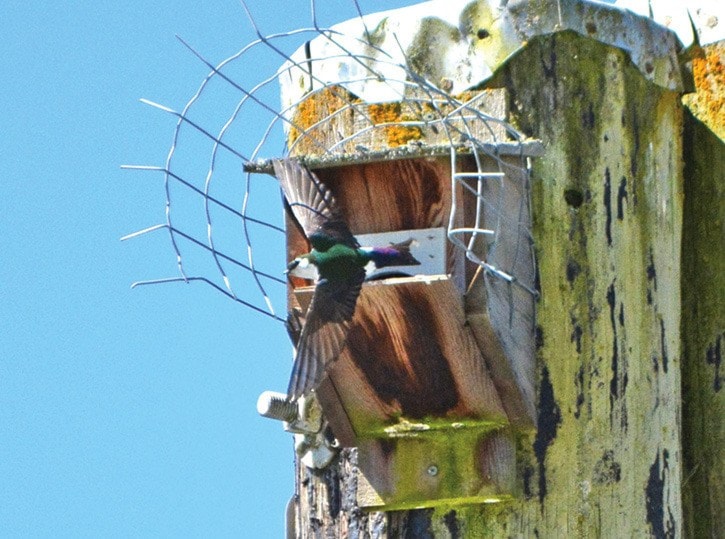In 1985, there were five breeding pairs of western purple martins left in the wild.
Well, “In the wild” isn’t even really accurate, as they were nesting in the portholes of an old decommissioned ship at the Department of National Defence dock in Colwood.
But then people with the Victoria Natural History Society and Western Purple Martin Foundation stepped in and started putting up nesting boxes to compensate for the loss of their natural habitat. Now, there are approximately 1,000 mating pairs that return to the area each spring from their winter migration to South America.
“There was a slow and steady increase over the first few years (of the nesting box program),” says foundation director Charlene Lee. By about 2002, she adds, there were approximately 200 pairs. It was evidence the program was working and the foundation received funding to expand the program.
“We weren’t sure, being a swallow, that they would take to the boxes,” Lee says, as many swallows are very territorial about their nesting areas. Once the birds did start using them, it became clear that expansion of the program could be the help needed to ensure the birds’ continued survival.
More boxes were put up at the DND docks, for a total of about 40, which see 30 nesting pair of martins return each year. Others went up at Royal Roads University (30 boxes total, 20 returning pairs), Goldstream Park got a few (now up to 15) and seven were installed at Pedder Inlet near Pearson College, whose boxes saw occupancy in the first year after being placed in 2013.
The purple martin’s instinctual nesting habitat is in the holes woodpeckers make in old burned out trees and other dead or dying wood. These days, Lee says, those areas are forested rather than left to nature, creating a lack of area for the birds to nest upon their annual return from South America.
 The growth of the population also has a lot to do with luck – at least the meteorological kind.
The growth of the population also has a lot to do with luck – at least the meteorological kind.
Lee says there needs to be the right kind of weather at the right time to create the natural circumstances that support increased numbers.
“From 2002 to 2006 we had really good summers for bugs,” she says. Martins survive off large bugs like moths, beetles and dragonflies, as opposed to smaller ones like mosquitoes, so if those types of insects aren’t plentiful when the martins are trying to feed their young, progress is lost in the resurgence efforts. If it’s too wet at the wrong times or for too long, not enough of the birds’ preferred diet is produced for the ones that are trying to survive, let alone to feed their young.
“A week of rain is no good,” Lee says, “but a day or two is okay.”
So it remains to be seen what the numbers will be like this year. The first ones are expected to return to the area to nest in late April.
“It was a thrill to quietly spy on these birds last summer and see them using the nesting boxes,” says Danielle Pope, who works at Pearson College, the newest of the sites being served by the nesting boxes in the region. “I hope we will see them again this year. They are incredible birds to watch in flight. Even though they are North America’s largest swallow, they have a great deal of agility and use the wind currents to help them float and dive. It’s quite something to see.”
While the nesting box program is not actively being expanded now, if people are willing to volunteer to put up boxes and manage them, the foundation certainly encourage that. Lee points out that martins are not a “backyard bird,” as they like wide open areas with water nearby.
If that sounds like a property you know of – one you think might make a good home for these struggling members of our community – head over to the foundation’s website at saveourmartins.org or by contacting Lee directly by emailing her at wpmf@georgiabasin.ca.
She can also point you to the plans for how to make the nesting boxes and can mentor people through the process, so the purple martin can be given a fighting chance.
